
On December 1, 2025, RapidDeploy proudly presented the Q4 2025 RapidDeploy Superstar Award to four outstanding telecommunicators from Kentucky State Police (KSP) Post 1: Alisha Cooper, Kim Newsome, Alaina Ramage, and Chad Spain. This team demonstrated incredible poise, teamwork, and life-saving decision-making during a high-risk domestic violence incident earlier this year.
The RapidDeploy Superstar Award honors telecommunicators who go above and beyond the call of duty, using modern technology and rapid response skills to make a lasting difference when every second counts.

On the morning of March 7, 2025, telecommunicators at KSP Post 1 received multiple 911 calls from the same number. Each time, no sound came through. With no voice to guide them and no immediate location data, the team quickly recognized that this might be more than a misdial.
Recognizing a potentially dangerous situation, they launched a text conversation using their CAD system's text-from-911 capability, which enabled them to communicate with the caller via SMS. Unfortunately, what followed was a chilling back-and-forth that revealed the caller had been physically assaulted and was trapped in a moving vehicle with her assailant. She couldn’t speak out loud because the person who harmed her was sitting beside her in the moving vehicle. Further complicating the situation, her phone’s microphone was broken, and her glasses had been smashed during the assault, making it difficult for her to see street signs or nearby landmarks.
Despite these obstacles, the KSP telecommunicators remained focused, calm, and connected. As the situation unfolded, the caller also revealed she was pregnant and that the man driving had threatened to intentionally crash the car in an attempt to harm her and her unborn child.
Thinking quickly, the team used RapidDeploy’s Radius Mapping to track the movement of the caller in real time, and then used the RapidLocate feature within Radius Mapping to access the caller’s precise GPS data and pinpoint the vehicle’s location, tracking it while it was in motion.
The telecommunicators then relayed key information to nearby law enforcement agencies, including the Fulton County Sheriff’s Department, who were able to stop the vehicle on I-69, just two miles before leaving the state and crossing into the Tennessee state line.
The suspect was taken into custody, and the caller was brought to safety.
“The quick actions of telecommunicators Cooper, Newsome, Ramage, and Spain, and the technology RapidDeploy, saved a life this past Friday.” said Gary Fraser, Public Safety Telecommunication Manager for KSP Post 1
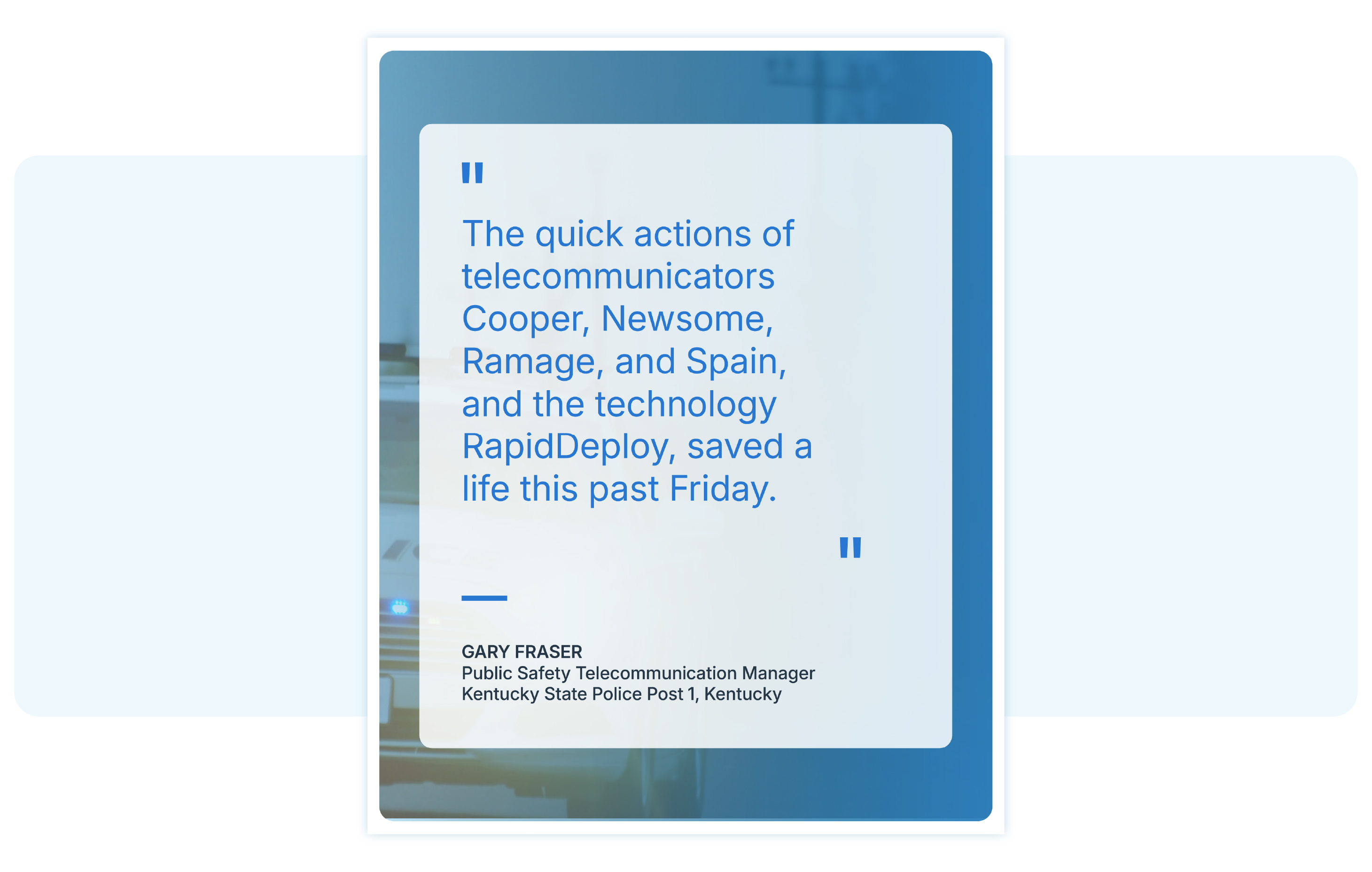
This incident reflects the real-world power of Next Generation 911 (NG911) technology and the crucial role it plays in today’s emergency response centers. Silent calls, mobile emergencies, and rapidly changing situations require tools that go beyond traditional voice-only communication.
With tools like Radius Mapping’s RapidLocate, telecommunicators are empowered to extract life-saving details even when the caller can’t speak. The story from KSP Post 1 is a powerful example of what’s possible when smart technology is combined with expert judgment and teamwork.
If you’re looking to deepen your understanding of how NG911 capabilities help protect callers in complex and time-sensitive situations, explore our guide: Enhance Caller Safety with NextGen 911 Technology.

This resource walks through the life-saving capabilities of tools like RapidLocate, RapidVideo, and Smart911 Safety Profiles, showing how each plays a role in reducing response times and enhancing public safety outcomes.
Sadly, the situation the KSP team responded to is not unique. Across the country, there are growing numbers of cases where callers cannot speak freely due to being in the presence of an abuser or a dangerous individual. That’s why features like RapidLocate are essential in modern 911 response.
In a case in Ventura County, California, a 17-year-old human trafficking victim was able to send a text to 911 in Spanish. Using RapidDeploy’s text-to-911 with AI language translation, telecommunicators were able to bridge the language gap, gather key location details, and coordinate a successful rescue, entirely through text.
Download the Ventura County Case Study to learn more about how RapidLocate was used to help rescue this human trafficking victim.

Both the Ventura County, California, and Kentucky stories highlight a critical need in emergency communications: the ability to provide safe, discreet, and reliable ways for callers to connect with help, even when speaking out loud could escalate danger.
We were honored to celebrate the KSP Post 1 team in person on December 1, surrounded by colleagues and leadership who recognize the value of their work. The Superstar Award ceremony is both a moment of recognition and a chance to spotlight the often unseen professionals whose quick thinking and smart use of tools change lives every day.
These four telecommunicators showed what’s possible when technology meets resiliency.
The telecommunicators at Kentucky State Police Post 1–Alisa Cooper, Kim Newsome, Alaina Ramage, and Chad Spain–are a powerful reminder of why we created the RapidDeploy Superstar Award. Their quiet courage, sharp instincts, and use of RapidDeploy technology helped save a woman and her unborn child during a moment of real fear and danger.
Watch the full story told by the telecommunicators in this video below, and see how we celebrated these telecommunicators and the entire team at Kentucky State Police for their life-saving actions.
At RapidDeploy, we created the Superstar Award because these quiet professionals deserve to be seen. Too often, their stories go untold, and potentially every time they pick up the phone, they may need to carry someone’s worst moment. We support and recognize that they need to muster up all of their strength, clarity, and compassion to help someone through their emergency. This matters, and Superstars matter.
We want to celebrate those moments. If you know a telecommunicator who has made a difference, tell us. Help us recognize them in a way that feels right, whether it's nominating someone for a Superstar Award, a team shoutout, or a quiet thank you. If they’re camera shy, that’s okay. We’ll meet them where they are. What matters most is giving them the recognition they deserve from the communities they work so hard to protect.
Nominate a telecommunicator today and help us shine a light on the people who make a difference when every moment matters.

Location data is a cornerstone of effective emergency response. From the instant a 911 call is placed, knowing the caller's location, the precise site of the incident, and the real-time position of every responding resource is critically important. When public safety agencies and all responding teams know exactly where other responders are in relation to an ongoing emergency, resources can be allocated more effectively, tactical decisions can be made more safely, and communication can flow seamlessly across teams and units. A recent study found that having location capabilities for emergency response personnel led to better situational awareness and improved overall response (Globestar).
However, when a field responder is off-duty or on a break, it is important for the emergency communication center to know that a law, fire, or EMS responder is not actively on duty, and therefore they should NOT dispatch the off-duty responder to the scene of the emergency. In this blog post, we’ll explore how Lightning’s new Workforce Status feature supports privacy, gives users control over their visibility to the Emergency Communications Center (ECC), and ensures agencies have accurate data during critical moments that matter.
At the heart of RapidDeploy’s solution is a commitment to unified situational awareness, powered by detailed, precise mapping. The Radius Mapping platform and the field responder-focused Lightning mobile app work together to create a single, shared operating picture. Mission-critical data—such as caller location, points of interest, and responder positions—is consistently visible in both the ECC and on the responder’s mobile device. This cohesive mapping environment allows telecommunicators and field responders to make real-time decisions based on the same, complete view of the emergency.
However, without the ability to give field responders control over their on-duty or off-duty status, a responder’s location could potentially be shared continuously, leading to an inaccurate reflection of their proximity to an event and their ability to respond quickly. To mitigate this, RapidDeploy has introduced Workforce Status. Now available in the Lightning Mobile App, responders can self-select their status with a single tap, choosing between “On Duty”, “On a Break”, or “Off Duty.” Then, this status is used to determine a responder’s visibility on the map; only those responders who are “On Duty” will have their active location information shared with other responders and the dispatch center.

With this added layer of control, agencies can now rely on location data as a true reflection of who is available in the field to respond to an emergency.
Accurate information is central to actionable 911 intelligence. By showing only who is on duty and active on the Radius and Lightning maps, the wider team now knows who is available in the critical moments of an emergency. This capability helps to reduce uncertainty and improve resource coordination, eliminating time that may otherwise be spent tracking down personnel or radioing updates to see who is available.
When responders have a transparent view of team locations and resources, they can better manage their response strategy, keep track of officers, and prioritize officer safety. Sergeant Steven Puryear of the Reedley Police Department in California emphasized this when recalling a recent emergency where his team was tracking down a stolen car. Visibility into team locations increased overall collaboration and the speed of their response:
“During a stolen car call, we used the app’s AVL feature to coordinate seamlessly in the field. Without needing to rely on constant radio communication, we split up based on our mapped locations and quickly tracked down the car. The app made teamwork effortless.”

Location accuracy becomes even more important during large-scale or cross-disciplinary incidents, where interagency collaboration and resource planning are critical. Without clear, shared availability statuses of the responding workforces, coordination could slow or even break down.
During the 2023 Maui wildfires, telecommunicator Johnel Davila detailed how vital it was to have Radius Mapping as a resource to facilitate communication, understand where responders were located, and make resourcing decisions.
These real-world stories exemplify how location data strengthens coordination across emergencies, from everyday calls to mass emergencies. When responders can trust that responder location and mapping data reflect the true status of the responders in the field, agencies gain the clarity they need to make faster decisions, reduce response times, and protect both their teams on the frontlines and the communities they serve.
As Next Generation 911 becomes embedded in agency operations and workflows, it’s more important than ever to protect information that is shared. The Workforce Status capability in Lightning helps strengthen this foundation by giving responders the autonomy to manage their own visibility in the field. When responders can self-select when their location is shown, this honors privacy and cultivates trust.
Beyond the right to privacy protection, giving responders more autonomy has been shown to improve morale, strengthen retention, and lead to healthier team dynamics. This is especially true for younger responders entering the workforce who are accustomed to transparency and control over the tools they use. During the COVID-19 pandemic, a mixed-methods study found that when responders have feelings of autonomy at work, there is less turnover and role abandonment (SAGE Journals). Another study found that having control and autonomy helps to minimize the emotional labor experienced when working in post-disaster environments (Brooks et Al., 2018).
Workforce Status in Lightning supports these expectations and helps to create an environment of trust, transparency, and respect. This directly benefits everyone involved: responders know their location is private when they are not active, and telecommunications receive reliable location data that is self-reported and precise. This balance leads to more engaged teams, healthier operational dynamics, and ultimately, better outcomes for the communities they serve.
While accurate location data is essential during the height of fast-moving emergencies, it also plays an important role in resource planning. Over time, a transparent history of responder location gives supervisors a clearer view of how, when, and where teams are deployed, including when resources are unavailable or maxed out. This data can be used to better inform staffing decisions, shift planning, and inform long-term resource strategies to help prevent burnout and support a sustainable workload across employees and agencies.
A clear record of responder availability and location data also strengthens post-emergency reporting. Supervisors can more accurately analyze response timelines, identify points of friction, and refine protocols based on what actually happened. The result is a more accountable, informed, and resilient operational environment that continuously improves with each incident.
As public safety agencies continue to adopt NG911 and data-driven tools, empowering responders with control over their shared location information will be essential. Workforce Status marks an important shift away from top-down systems and gives responders the keys to managing their own availability, privacy, and workflow. For responders, this empowers accountability, protects personal time, and fosters a healthy working environment. For agencies, this means more accurate data, better decision-making, and an accurate reflection of what’s happening in the field.
When responders are working from the same source of truth, coordination becomes smoother and response becomes stronger. Workforce Status is a meaningful step toward that future, giving responders control over their visibility and agencies the clarity they need for safe, effective operations.

67% of parents and teachers are more concerned about school safety now than they were five years ago, according to Motorola’s 2023 School Safety Report. Across the country, schools, legislators, and responders are working hard to build safer environments for students and staff. School districts have created emergency operating plans and routinely implement drills and exercises while innovation in new technology equips responders with critical information to prevent, circumvent, and minimize the impact of emergencies.
While prevention remains the ultimate goal, the reality is that when an emergency does occur, the speed and effectiveness of the response can help save lives. When a 911 call comes in from a school or a panic button from within a school is pushed, it can take telecommunicators time and resources to piece together fragmented information. If outdated systems are in place, this means the telecommunicator needs to organize critical information and determine what is necessary to share with responders, staff, and other stakeholders. Key details such as knowing the precise location of the threat, the number of people involved, and if anyone is harmed could speed up the decision-making process in the field or even change the response strategy. Information gaps and delays cost precious time and can impede critical decisions when every moment matters.
RapidDeploy's Lightning mobile application bridges this gap, delivering Next Generation 911 intelligence directly to field responders' mobile devices in real-time. Critical details such as the caller location, building floor plans, live incident updates, and live camera footage are available in real-time on responders' mobile devices. The result: responders arrive at the scene equipped with a full picture of the emergency and immediate access to evolving information. Real-time, actionable information has become a force multiplier for school emergencies, leading to time saved, improved outcomes, and the potential to help save lives.
In this blog post, we’ll explore how the Lightning mobile application empowers first responders during school emergencies.
School emergencies are inherently complex and fast-moving. The type of emergency incident at a school could range from a false alarm to a need for multi-layered response, such as during a medical crisis, active shooter, or fire. Information is often fast-moving and may come from multiple sources over time. Resources need to be carefully deployed and prioritized, with every decision potentially changing the outcome of the situation at hand.
One of the biggest challenges of a school emergency is pinning down the precise location of the incident. The physical layout of a campus might span several buildings or floors, with different layouts from school to school. More than half of school safety incidents occur in areas such as hallways, parking lots, or sports fields, where visibility is limited and locations are harder to pinpoint (CENTEGIX, 2024). Without advanced technology, responders might arrive on the scene and not know the exact location of the caller, threat, or incident. Precious time might be spent searching buildings, and resources could be deployed ineffectively. Threats can move, injuries might go unattended or people harmed. Having a complete picture of location details is critical to effective response.
Another common challenge for school emergencies is determining the difference between a false alarm and a true emergency. Approximately 90% of bomb threats, for example, turn out to be pranks (Arizona State University). Access to real-time information in the field enables the responding team to escalate or de-escalate the nature of the emergency, potentially saving resources that could be better allocated to different emergencies.
Communication issues compound these challenges. Callers might be unable to speak if they are in imminent danger, making it even more challenging to determine their location without technology tools. Multiple calls could come in at once, each with important details that impact decisions. Ultimately, the time spent parsing critical details and piecing together a full view of the incident could have been spent actively containing the emergency.
In this video, telecommunicators describe an incident at a school in Anderson County, South Carolina, where callers felt unsafe during a school lockdown. The telecommunicators swiftly moved the call to text so students inside the school could communicate without speaking.

RapidDeploy's FirstNet VerifiedTM Lightning mobile app bridges critical information gaps and communication delays by delivering Next Generation 911 intelligence directly to field responders' smartphones and tablets. Powered by Radius Mapping, Lightning extends the capabilities of the ECC into the field, providing officers, firefighters, and EMS personnel with the same real-time data and situational awareness that telecommunicators see on their screens.
Key Features Include:
To ensure seamless coordination without information overload, Lightning intelligently distributes tailored information to responders based on their specific role through a functionality called “Disciplines.” While the location of AEDs might be critical for EMS, for example, police are likely more concerned with optimal access points and positioning. Lightning ensures all agencies arrive with the same foundational intelligence (floor plans, location of callers, live video feeds) but prioritizes information to ensure time is spent effectively. Role-based intelligence mitigates coordination issues and enables a more efficient response by building a common operating picture unique to the incident and responder.
For school emergencies, Lightning has a transformative impact. From pre-arrival intelligence to ongoing situational awareness, instant access to critical information fundamentally shifts the response strategy, saves critical time, and has the potential to save lives.

When responders have access to Lightning, they are equipped with a wealth of pre-arrival intelligence at their fingertips. The more information responders have before arriving on scene, the better prepared they are to make decisions and act quickly. During the critical moments they are en route to a school emergency, dynamic information in Lightning lets responders identify ideal entry points, map out the fastest path to help those in need, and coordinate with other teams in a matter of minutes.
Data Received in Transit Informs:
To maximize pre-intelligence capabilities for first responders and ensure the fastest, most effective response possible, Lightning integrates seamlessly with mission-first, cutting-edge partners who share a relentless focus on making school environments safe::
When seconds can make a difference, responders must arrive prepared and ready to act. From the moment a call is received to arrival on the scene, the flow of information and communication needs to be instantaneous. Lightning makes this possible, leading to more effective decisions, safer operations, and critical seconds saved.
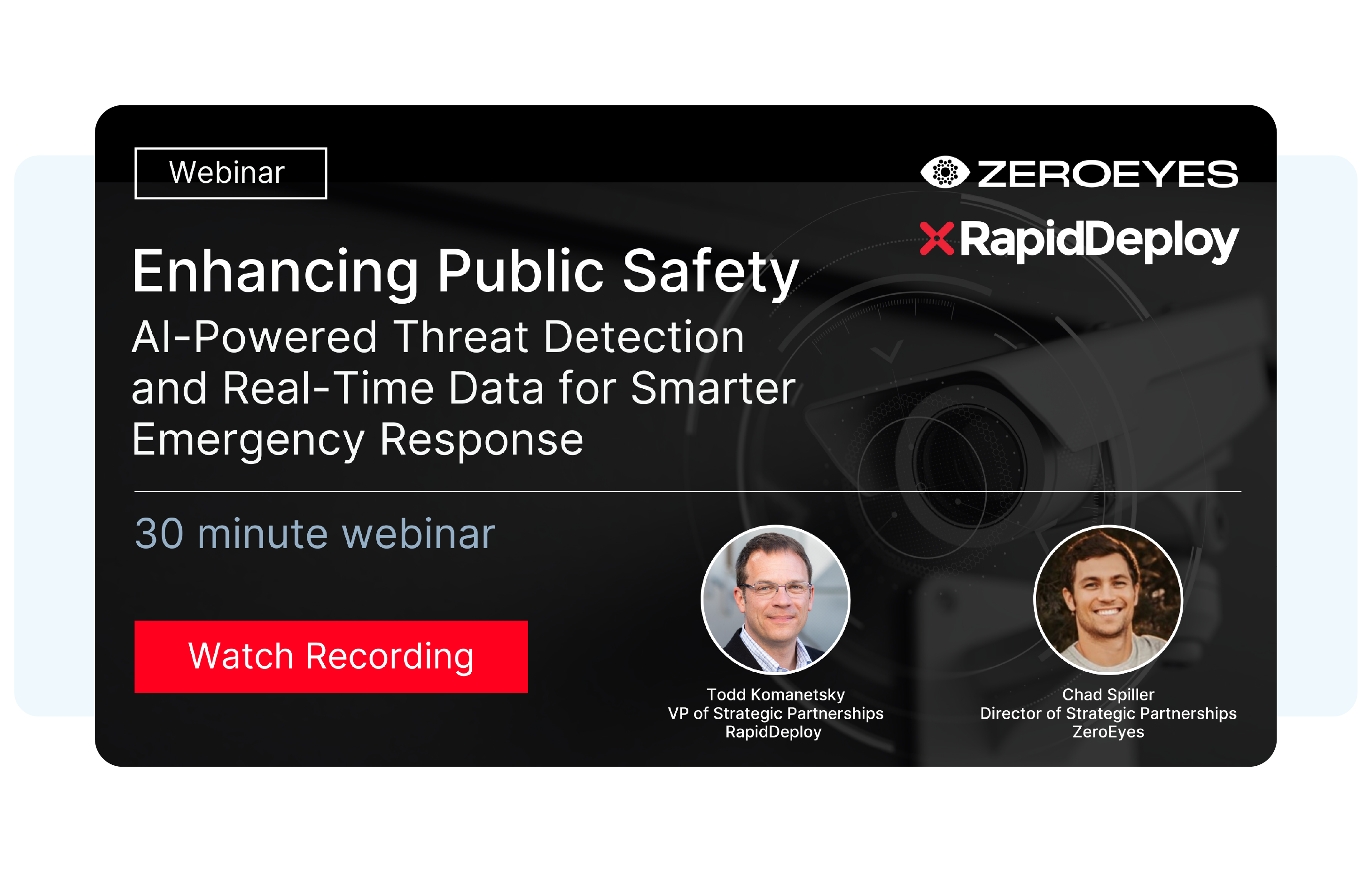
While pre-arrival intelligence helps responders coordinate the initial response strategy, school emergencies rarely remain static. Additional calls come in with new details, incidents move, and the nature of the threat can escalate or de-escalate within minutes. Responders need continuous access to real-time intelligence that adapts as emergencies unfold.
Lightning provides an evolving 360-degree view of school emergencies through a suite of real-time capabilities, including live video streaming, responder tracking, and two-way SMS communication.
Dynamic Intelligence Informs:
This continuous flow of intelligence ensures emergency teams maintain situational awareness throughout the entire incident. Responders are enabled to deploy resources strategically, coordinate with on-site personnel, and adapt their response as conditions change on the ground.
Across industries, access to information and technology levels the playing field. This is also true for emergency response, and in particular for complex scenarios like school emergencies. Delivering equitable response becomes especially challenging when communication barriers exist. Callers may speak a different language, be deaf or hard of hearing. Some callers might be unable to speak during an emergency, whether due to their own health conditions or safety of the environment around them. Lightning's built-in capabilities, including real-time translation and two-way SMS texting, help ensure communication barriers don't compromise response or delay time when responding to a school emergency.
By providing the same level of data, technology, and communication capabilities to every responding unit, Lightning helps create more equitable emergency response within communities that deploy the technology. And with Lightning’s real-time data feeds, responders are enabled to deliver a consistent, coordinated response across the entire district, whether responding to a small elementary school or a large urban campus.
Next Generation 911 is fundamentally changing how responders react when a school emergency unfolds. Lightning optimizes how time is spent from the moment a call comes in to when responders arrive at the scene, ensuring they arrive on campus with comprehensive intelligence. As conditions change and more information trickles in, field responders have immediate access to updates in order to evolve their response. Information is delivered instantly and intelligently in the palm of their hands, with role-based information and tools for seamless coordination.
For schools, this means informed decision-making, a more equitable response, an effective use of resources, and ultimately precious time saved during critical moments. When outcomes can change in mere seconds, Lightning equips field responders with the intelligence they need to protect students and staff.
To learn more about how Lightning can enhance emergency response in your jurisdiction, visit rapiddeploy.com/lightning.

Every year on October 28, National First Responders Day gives us a moment to pause and recognize the people who step forward when others are in need. Firefighters, police officers, paramedics, and 911 telecommunicators are often the first connection in an emergency. They are the calm voice, the steady guide, and the link between crisis and help.
Recently, that recognition took an important step forward. In a historic move, the U.S. Senate unanimously passed the Enhancing First Response Act (S.725), legislation that calls for the reclassification of 911 telecommunicators under the “Protective Service Occupation” category in the federal government’s Standard Occupational Classification system. This aligns with the long-standing goals of the 911 SAVES Act, a bill supported by public safety advocates for years. While this reclassification has not yet been finalized at the federal level, the Senate's action represents a major milestone in recognizing 911 professionals for the critical, life-saving work they do. RapidDeploy applauds this progress and the tireless advocacy from public safety leaders and organizations like NENA and APCO who have helped bring national attention to the role of telecommunicators as essential first responders.
At RapidDeploy, we are proud to support this community through the technology we build and the stories they share. National First Responders Day is not just a date on the calendar for us. It is a chance to reflect on the mission that drives everything we do.
One of the most meaningful ways we celebrate that mission is by lifting up the voices of the next generation.
This fall, we partnered with NCT9-1-1 to host the second annual 911 Heroes Art Contest. This year we expanded the contest to K–12 students across North Central Texas, and invited students to create original artwork honoring first responders in their communities.
We encouraged each artwork representation to include a 911 telecommunicator, or a symbol that represents a telecommunicator or PSAP. Many students chose to include the full spectrum of public safety professionals, including firefighters, EMS personnel, and law enforcement officers.
This year, more than 600 students submitted artwork. Many also recorded short videos describing what inspired their pieces. Their words were thoughtful and honest, reminding us just how clearly young people recognize the importance of those who protect and serve.
In 2024, we were proud to help bring two student-inspired murals to life, each one a celebration of community, creativity, and the people who answer the call.
The first mural was based on the winning artwork from Landrie Reeves, a sixth grader at Stafford Elementary. Her drawing stood out for its heartfelt message and detailed depiction of first responders working together, including fire, EMS, police, and 911 telecommunicators. That piece became the inspiration for a public mural in Italy, Texas, Landrie’s hometown, where it now stands as a personal and powerful tribute to the profession she chose to honor through her art.
The second mural was painted in Bridgeport, Texas, and took shape through a unique collaboration. Students from Miss Dickerson’s art class at Bridgeport Middle School submitted entries as part of the 2024 contest. Several of those submissions were selected and thoughtfully combined into one cohesive design, brought to life by a local muralist. Installed on the historic Bridgeport Hospital building, the mural was unveiled during a community celebration on March 5.
While Landrie’s mural reflected the individual vision of a single young artist, the Bridgeport mural became a collaborative tribute, both honoring first responders in different, but equally meaningful ways.
.png)

We are proud to announce the winner of the 2025 911 Heroes Art Contest:
Selene M., an 8th grader from Dublin Secondary School.
Selene's artwork was selected for its creativity, emotional depth, and a clear message of unity among first responders. It captures the spirit of courage, collaboration, and care that defines emergency response work.
The winning piece will be transformed into a public mural in North Texas, with installation scheduled for 2026. New this year, In recognition of their achievement, the student will also receive a scholarship contribution from Motorola Solutions to support their future education and creative journey.

In addition to the mural winner, we’re thrilled to feature the top 10 entries selected for our special First Responder Coloring Book. These pieces, created by students in grades K–5, will be shared at public safety events and in classrooms across Texas.
Take a look at their incredible work below. Each image celebrates the heroes behind the scenes and on the front lines.

Now in its second year, the 911 Heroes Art Contest brought in dozens of thoughtful and creative submissions from K–12 students across North Central Texas. A panel of judges carefully reviewed the entries and selected ten standout pieces to be featured as finalists in the public voting round.
These works reflect more than just artistic skill. Each one is a personal expression of gratitude, a young person’s way of honoring the people who serve their community in moments of crisis.
From bold colors to intricate detail, these pieces captured the spirit of first response and the heart behind the headset. We’re proud to share this year’s top 10 student tributes below.
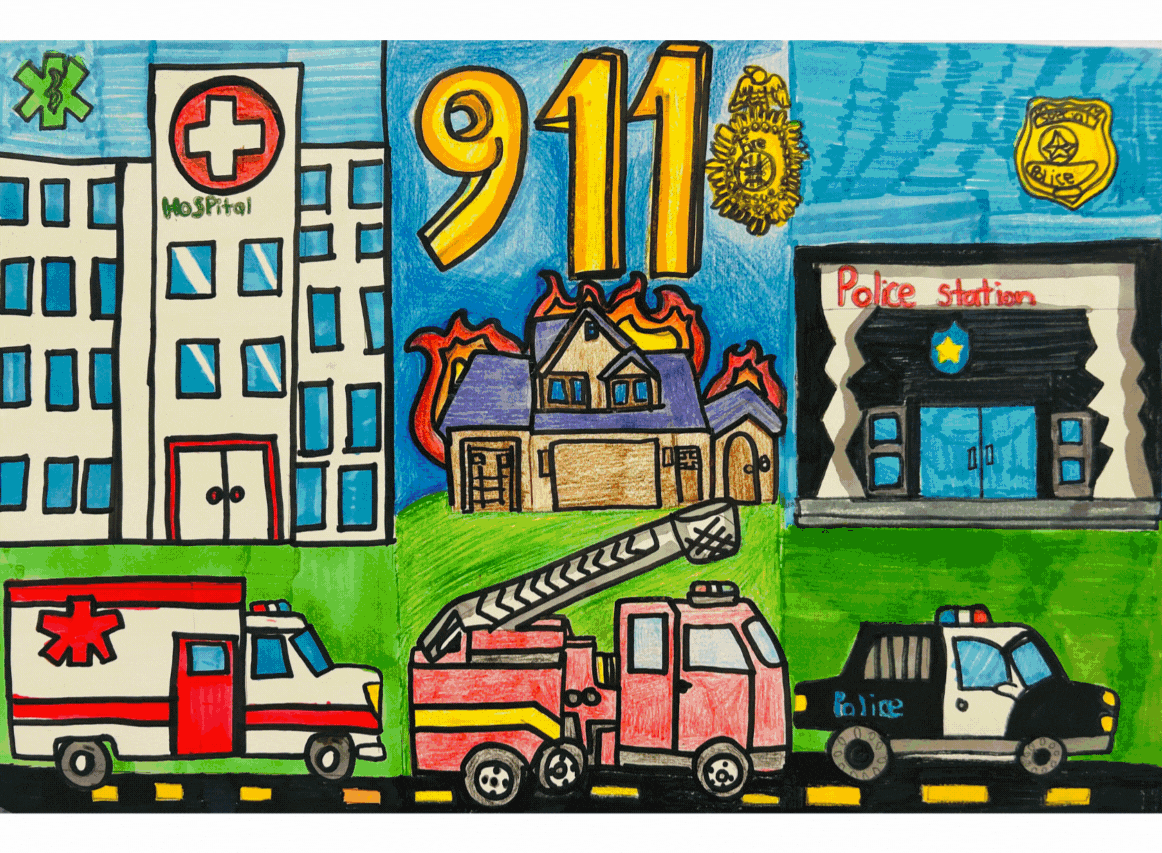
Their art reminds us that appreciation can come in many forms, and that first responders leave a lasting impression on even the youngest members of our communities.
This year’s campaign invited something new: spoken gratitude. Alongside their artwork, student artists and children of RapidDeploy and NCT9-1-1 employees were encouraged to share short video messages for the people who show up when it matters most.
What was captured is simple, personal, and moving.
The 911 Heroes Art Contest began as a way to celebrate first responders and engage the next generation through creativity and community. Over the past two years, we’ve seen just how powerful that connection can be: from mural dedications and classroom participation, to heartfelt messages from young artists who are already showing us what gratitude looks like.
We often talk about NextGen 911 as a leap in technology with a future built on data, speed, and smarter tools. But this campaign reminded us that the next generation is already stepping up to support public safety with creativity, compassion, and a deep appreciation for the people who serve.
While this program began in partnership with NCT9-1-1, we believe it could serve as a model for other communities looking to recognize and celebrate their own first responders in meaningful ways.
If your agency, school district, or community is interested in learning more or exploring a potential partnership, we’d love to hear from you.
You can reach us through our contact form.
To every student who submitted artwork, to the teachers and families who encouraged them, and to the first responders who continue to inspire all of us, thank you.
Your service is seen. Your impact is felt. Your work matters.
From all of us at RapidDeploy, happy National First Responders Day.

School safety is one of the most critical public safety challenges facing communities today. Whether managing a major weather event, a medical emergency, or an act of violence, schools demand immediate, coordinated response.
Oftentimes the current system fails this test. While 80% of teachers and 73% of parents are confident in their school's emergency plans, a 2023 Motorola Solutions K-12 School Safety Report reveals a stark operational reality: over half of teachers (57%) still rely on calling the main office via a classroom phone in an emergency. This manual step creates unacceptable friction, failing to simultaneously loop in 911 telecommunicators and first responders who need to act in seconds.
This means that in the 911 workflow, critical intelligence may be fragmented or trapped across isolated databases, legacy CAD systems, and school-specific platforms. When lives are on the line, the delay caused by this lack of a unified, shared operating picture could be a threat multiplier.
The partnership between RapidDeploy and Rave Mobile Safety is built to help solve this problem by leveraging the power of Next Generation 911 (NG911) technology. By eliminating an information exchange gap, public safety teams can help ensure every response starts with immediate, intelligent data.
To read more about how RapidDeploy and Rave Mobile Safety are creating safer responses together, check out our blog post from May of this year, The Power of Shared Data: How California Is Boosting Officer Safety and Efficiency with Lightning.

Legislation like Alyssa's Law, which mandates public safety systems like silent panic alarms are directly linked to law enforcement, prioritizes and focuses on the need for faster, data-driven response to school emergencies.
While many solutions satisfy the technical mandate of the panic button, meeting the spirit of the law requires more than just an alert signal. It requires providing the receiving Public Safety Answering Point (PSAP) with authoritative, site-specific data—such as floor plans, access codes, and pre-incident plans—in real-time when the panic button is pushed.
However, while the alert would notify the PSAP, fragmented data means the critical context would remain stuck behind a separate school security system.
The combined technology suite of RapidDeploy and Rave, both a part of the Motorola Solutions ecosystem, bypasses this friction, ensuring the necessary data flows instantly to Radius Mapping, the cloud-native mapping platform used by 911. The resulting response is truly compliant and life-saving.
RapidDeploy’s partnership with Rave Mobile Safety brings their critical, real-time safety data directly into our core mapping and response platform, Radius Mapping.
This integration converts scattered information into immediate, actionable intelligence, achieving three core outcomes across the entire emergency workflow:
Unified View of Data: Telecommunicators instantly view all critical data—Rave Panic Button alerts, caller location, and authorized school floor plans—on a single, dynamic map.
Streamlined Mutual Aid: Cloud-based data sharing automates cross-jurisdictional collaboration, enabling seamless, real-time coordination between police, fire, and EMS.
Field Intelligence: First responders gain pre-arrival situational awareness via mobile applications like RapidDeploy’s Lightning mobile app, ensuring they have floor plans and critical location data before they even arrive at the scene.
To learn more about our partnership, download the RapidDeploy and Rave Safer Schools guide.

The foundation of cross-agency response is the ability to share Computer-Aided Dispatch (CAD) and resource data without manual intervention. This is the core function of Exchange Link, the integrated data-sharing solution powered by the RapidDeploy-Rave partnership.
Traditional mutual aid is bogged down by manual phone calls and radio communications. Exchange Link eliminates this operational friction by connecting adjacent Emergency Communication Centers (ECCs) and first responders in real-time:
Sharing CAD Events: Critical CAD incident locations and essential details (type, severity) are automatically published and displayed on the Radius map of neighboring, authorized ECCs. This ensures agencies responding under a mutual aid agreement see the exact scope and location of the incident instantly.
AVL Tracking: Real-time Automatic Vehicle Location (AVL) data from neighboring agency vehicles is visualized on the map. This capability allows telecommunicators to deploy the closest, most appropriate resource—regardless of jurisdictional boundary—significantly speeding up deployment.
Intelligent Data Control: A sophisticated, user-defined rules engine allows agencies to specify exactly which CAD data (based on incident type and severity) is automatically shared, maintaining policy adherence while guaranteeing critical information reaches collaborating partners.
This automation is indispensable during a school emergency, ensuring every agency involved in the multi-jurisdictional response is operating from the same validated data set.

A unified, cloud-native system turns a high-stress incident into a sequence of coordinated, data-informed actions:
Step 1: The Alert is Initiated
A teacher identifies an emergency and activates the Rave Panic Button on their mobile device, specifying the incident type (medical, fire, active assailant). The high-fidelity alert is transmitted instantly.
Step 2: Immediate Situational Awareness at 911
The Rave signal is routed directly into the RapidDeploy Radius Mapping platform. The telecommunicator immediately receives unparalleled context before ever needing to speak to a caller, including:
Precise Location: The room-level or building-specific location of the alert initiator via indoor positioning.
Contextual Map View: Authorized school floor plans are automatically overlaid onto the dynamic map, providing immediate, actionable intel on building layout and access points.
Pre-Loaded Data: The call window populates instantly with pre-plan data, including emergency contacts, key-holder lists, and potentially live video feeds (if integrated), giving 911 "virtual eyes on the scene."
Step 3: Automated Coordination
Two essential actions happen simultaneously:
School Mobilization (Rave): School staff and faculty are immediately notified of the incident type and location, allowing them to initiate safety protocols (lockdown, shelter-in-place) without delay.
Responder Mobilization (RapidDeploy): The telecommunicator dispatches units. Via Exchange Link, the CAD data is instantly shared with required adjacent agencies. First responders in the field, using the Lightning mobile app, see the exact location, floor plan, and real-time AVL data of their approaching partners.
By integrating the panic alert directly with the mapping and CAD infrastructure, this cloud-native approach ensures critical data is delivered without adding a single extra step to the 911 telecommunicator’s high-pressure workflow.
The measurable success of integrated NG911 solutions is faster, smarter, and safer response. By connecting panic button alerts with real-time location and mapping, one school district in Texas reported a 50% reduction in response times, leading to faster resolution of both security threats and medical emergencies.
This integration goes further by addressing complex communication needs. NextGen 911 tools like text-from-911 and live video streaming are becoming essential, especially in situations where verbal communication is impossible or dangerous. The data shows this shift: text-from-911 increased 118% and live video streaming increased 70% from 2022 to 2023 in RapidDeploy systems. These digital communication pathways are indispensable for safely communicating with individuals during an evolving incident.
To learn more about the impact of Next Generation 911 solutions on school safety, download our Ebook: Transforming School Safety with Next Generation 911 Solutions.

School emergencies are fluid and unpredictable. Relying on fragmented systems, paper pre-plans, or time-consuming phone calls creates dangerous friction that slows down response.
The partnership between RapidDeploy and Rave Mobile Safety leverages the cloud to build genuine public safety resilience. By unifying Rave’s authoritative safety data with RapidDeploy’s cloud-native mapping platform, we ensure every emergency response team—from the dispatcher in the ECC to the officer en route—receives the real-time, convergent intelligence needed for informed decisions and coordinated action.
In the mission of school safety, data accuracy and response speed are non-negotiable. With a unified, cloud-native approach, every second is optimized to protect students, staff, and our communities.

In the field, every second counts. So does every decision. That’s why we built Lightning.
Whether you're Law, EMS, Fire, or part of another emergency response discipline, one thing is certain: having access to the right information at the right time can mean the difference between a successful outcome and a delayed response. At RapidDeploy, our mission has always been to equip responders with technology that helps them move faster, safer, and smarter. Today, we’re highlighting a powerful new capability in our Lightning mobile app: Disciplines.
Lightning extends the power of NG911 beyond the communications center and directly into the hands of field responders. Now, with Disciplines, Lightning becomes even more intelligent by adapting to each user’s assigned role in real time.
Disciplines is a dynamic feature that tailors Lightning’s interface, events, alerts, and map views to the responder’s discipline, whether that is Law, EMS, Fire, or another service. The result is a focused, distraction-free experience that puts only the most relevant information in front of each responder.
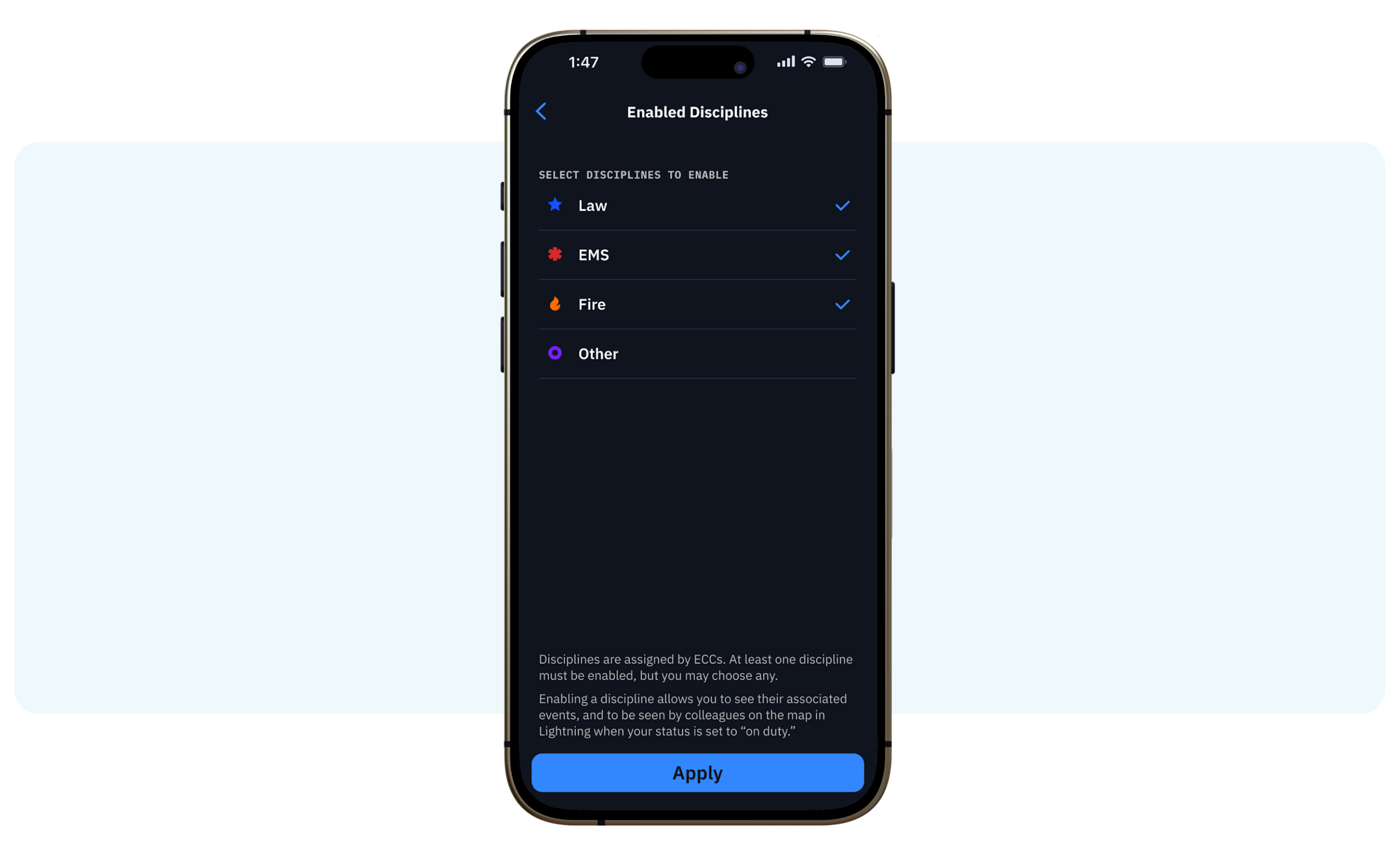
Context matters in emergency response. Cluttered maps, cross-discipline notifications, and irrelevant data can create noise during moments when clarity is critical. This can slow down decision-making at the exact moment when time matters most.
With the Disciplines feature in Lightning, responders gain a clearer, more focused view of what’s happening around them, based specifically on their role. Responders are now able to:
For example, a paramedic responding to a medical call at a crowded event, like a concert, does not need to see alerts about thefts at a nearby store, a fire-related incident across town, or traffic enforcement activities unrelated to their role. With Disciplines active, the paramedic's map and alerts are filtered down to show only EMS-specific content. This improves focus, reduces clutter, and enables faster action in time-sensitive scenarios.
As another example, consider this same EMS responder is assigned to a large-scale Fourth of July parade. The ECC is using Radius Mapping while the EMS responder is using Lightning to manage a shared operational picture, supported by Critical Incident Boards, geofenced alerts, and real-time responder locations. Dozens of map pins may be enabled in Lightning during this event: reports of heat exhaustion, missing persons reports, and suspicious activity. Suddenly, a 911 call comes in for a woman experiencing chest pains along the parade route.
Without Disciplines, the responder must sift through the operational noise of unrelated incidents to search through the map to locate the incident around the parade route. That search can cost precious time, however with Disciplines enabled, the map is filtered to show only EMS events and resources—like AED locations, triage zones, and pre-marked incident geofences. The paramedic can quickly identify the call, navigate using map markups created by the ECC, and coordinate with nearby responders using Lightning’s live location tracking. This clarity and focus can help her respond directly to the emergencies that she is responsible for, improving response time and care.
To learn more about using Lightning to manage the complexities of emergency response during live, large events, download our Ebook.
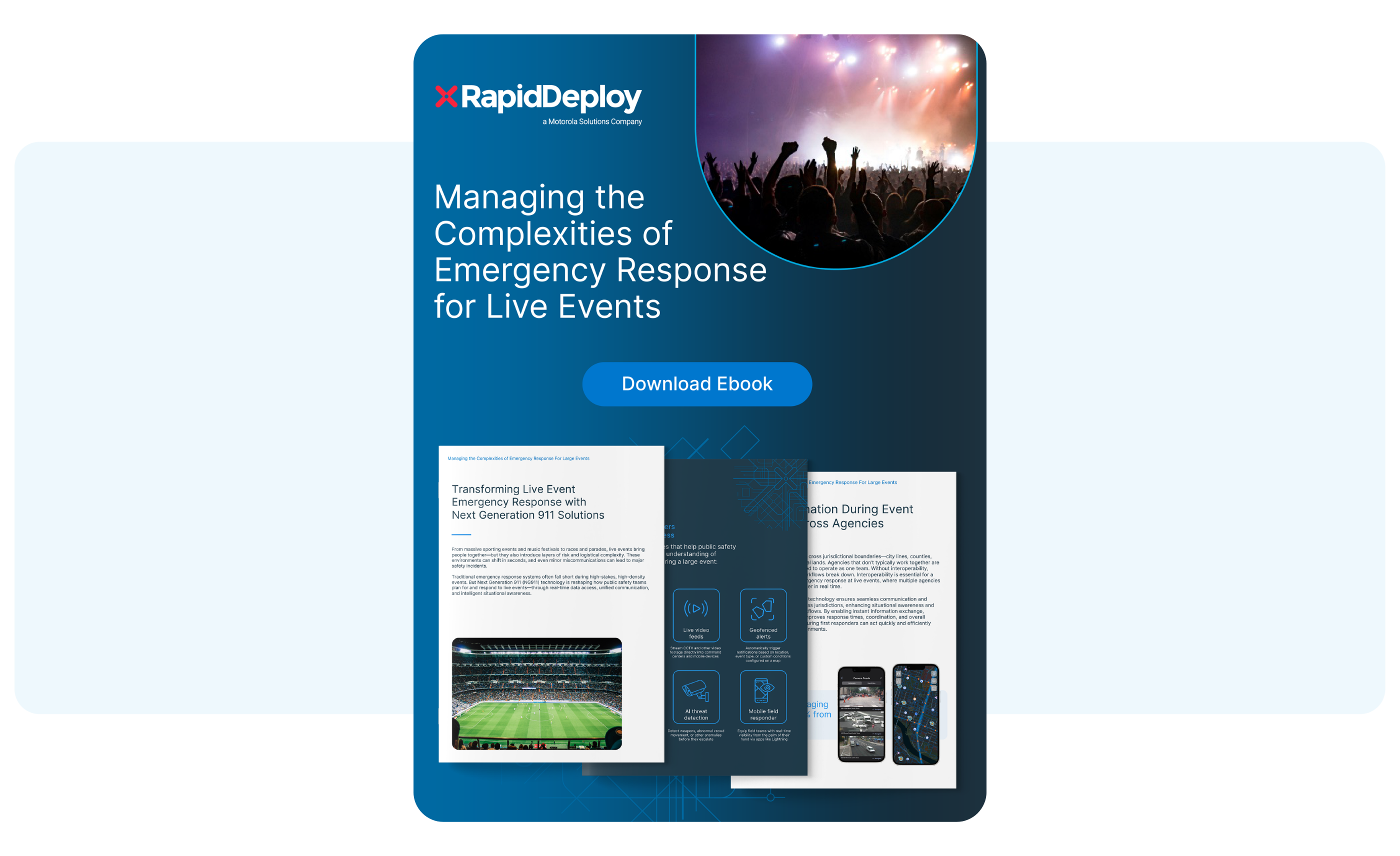
At RapidDeploy, our customers are at the heart of everything we do and the launch of our new Disciplines feature reflects that commitment. This enhancement was driven directly by our customers’ feedback—from ECC administrators seeking more control in Radius Mapping to field responders asking for a more focused mobile experience in Lightning, we heard you, and we acted. Disciplines was built to meet these needs, empower teams in the field, and ensure that our innovation and product enhancements are prioritized and built to help our customers respond faster, smarter, and safer.
Disciplines is part of the core Lightning experience, and is available to all Lightning-enabled ECCs equipped with Radius Mapping, with no separate activation needed. ECCs simply configure their desired disciplines in Radius Admin, and their responders will benefit from a personalized, filtered view in the field.
1. ECC Configuration in Radius Admin
ECC administrators define the list of Disciplines available within their agency (such as Law, EMS, Fire, or Other). They can assign one or more disciplines to each user, manage auto-assignment settings for calls, and determine whether responders see untriaged signals or not.
2. User Experience in Lightning
Responders open the Lightning app and select which of their assigned Disciplines they want to view. Lightning updates instantly to display:
3. Flexible Use with Administrative Control
Users who are assigned multiple disciplines can toggle between them in the app depending on their current assignment. ECCs retain control over which disciplines a responder is allowed to see, ensuring the right balance of flexibility and oversight.
As public safety agencies embrace the future of mobile-first emergency response, one emerging priority is ensuring that information delivered to the field is both real-time and role-specific. In high-pressure environments, overwhelming responders with irrelevant data can delay decisions and increase risk. To operate at peak efficiency, field teams need workflows and notifications that are filtered, focused, and purpose-built for their responsibilities.
By integrating this type of role-based response into mobile workflows, field responders will now have:
Disciplines also delivers significant benefits to the command center. While responders gain clarity and focus in the field, ECC administrators gain the tools and visibility they need to manage operations more effectively with:
To learn more about the role of NG911 in mobile response, download our latest Ebook Enhancing Field Operations, where we explore the role of disciplines in field response in greater detail.
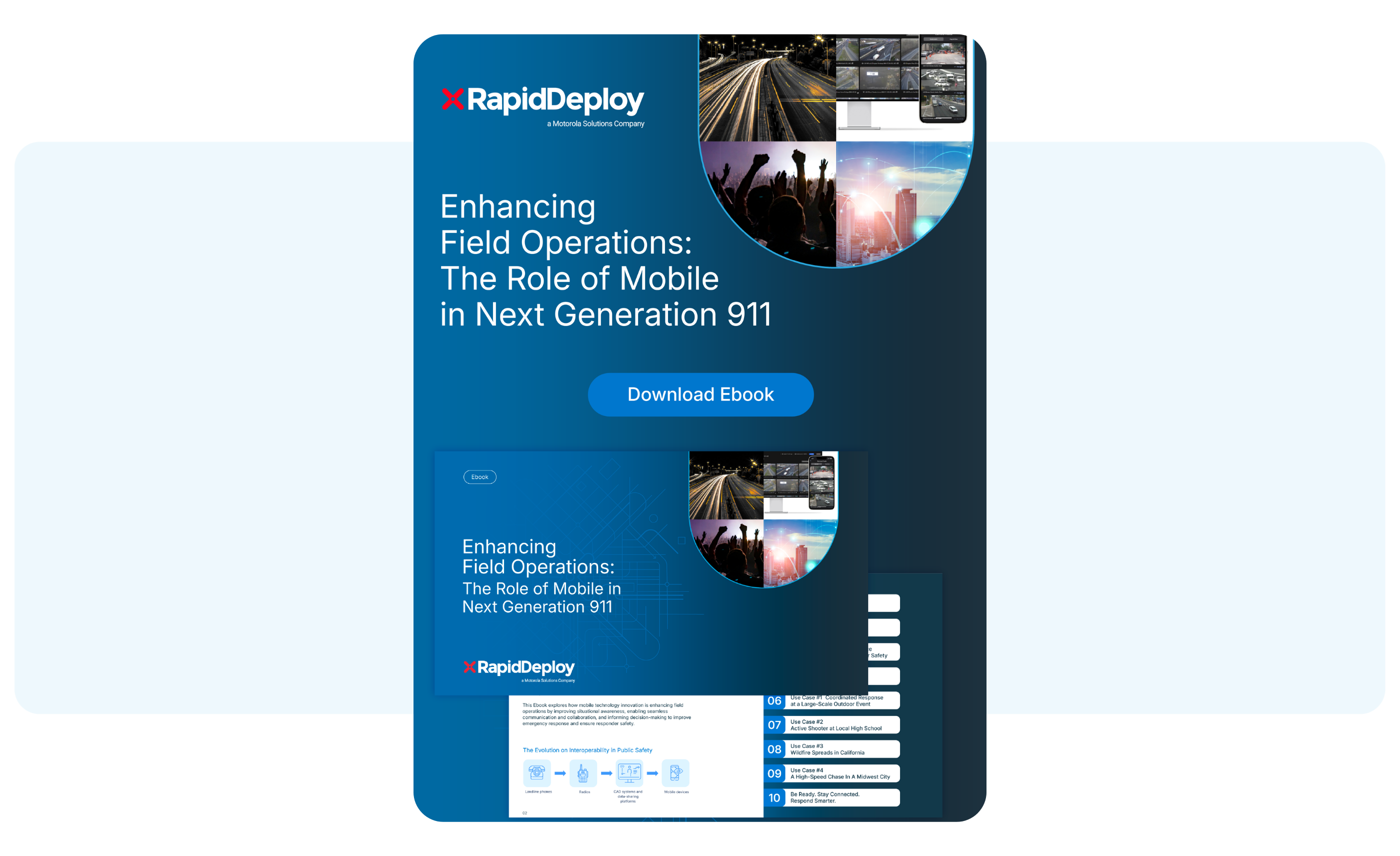
If your ECC is already using Lightning, Disciplines is available now. Administrators can begin setting up and assigning disciplines in Radius Admin today.
Disciplines is purpose-built for the complex demands of modern emergency response, and your teams can work faster, smarter, and safer than ever before. Now is the perfect time to equip your field responders with Lightning.
Every responder deserves a mobile experience built around their role. Now they have it.
Discover what role-based intelligence can do for your agency.

Need a walkthrough or demo?
Reach out to your RapidDeploy Customer Success Manager or contact us today to learn more.
🔗 Visit rapiddeploy.com/lightning for more information.